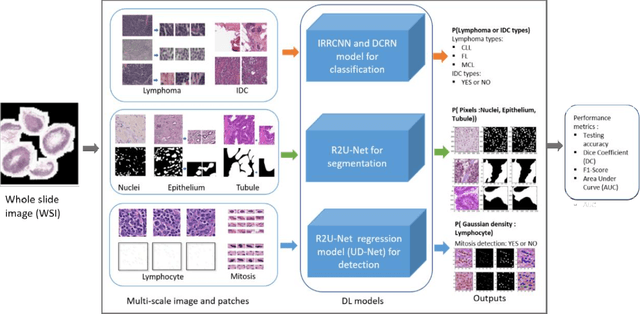Advanced Deep Convolutional Neural Network Approaches for Digital Pathology Image Analysis: a comprehensive evaluation with different use cases
Paper and Code
Apr 19, 2019



Deep Learning (DL) approaches have been providing state-of-the-art performance in different modalities in the field of medical imagining including Digital Pathology Image Analysis (DPIA). Out of many different DL approaches, Deep Convolutional Neural Network (DCNN) technique provides superior performance for classification, segmentation, and detection tasks. Most of the task in DPIA problems are somehow possible to solve with classification, segmentation, and detection approaches. In addition, sometimes pre and post-processing methods are applied for solving some specific type of problems. Recently, different DCNN models including Inception residual recurrent CNN (IRRCNN), Densely Connected Recurrent Convolution Network (DCRCN), Recurrent Residual U-Net (R2U-Net), and R2U-Net based regression model (UD-Net) have proposed and provide state-of-the-art performance for different computer vision and medical image analysis tasks. However, these advanced DCNN models have not been explored for solving different problems related to DPIA. In this study, we have applied these DCNN techniques for solving different DPIA problems and evaluated on different publicly available benchmark datasets for seven different tasks in digital pathology including lymphoma classification, Invasive Ductal Carcinoma (IDC) detection, nuclei segmentation, epithelium segmentation, tubule segmentation, lymphocyte detection, and mitosis detection. The experimental results are evaluated with different performance metrics such as sensitivity, specificity, accuracy, F1-score, Receiver Operating Characteristics (ROC) curve, dice coefficient (DC), and Means Squired Errors (MSE). The results demonstrate superior performance for classification, segmentation, and detection tasks compared to existing machine learning and DCNN based approaches.
 Add to Chrome
Add to Chrome Add to Firefox
Add to Firefox Add to Edge
Add to Edge